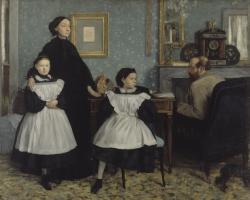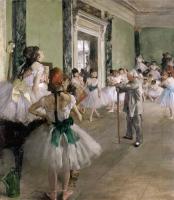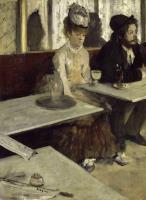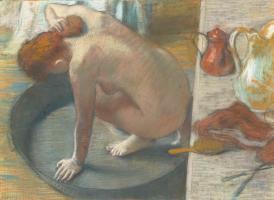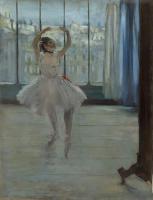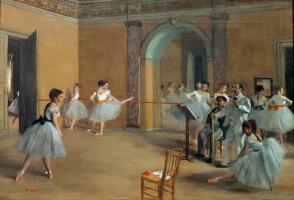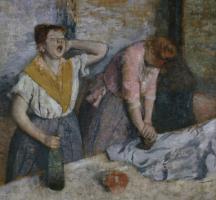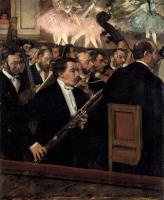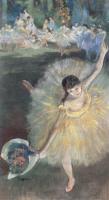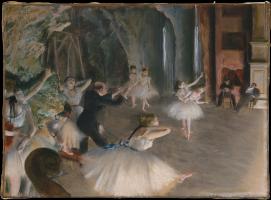Edgar Degas
Degas, born in Paris, was the son of a wealthy banker, and for most of his life he was free to paint without depending on his art for a livelihood. He was something of a recluse, troubled from his early forties with failing eyesight, a witty, formidable and forbidding character. He was a member of the Impressionist group for a time, but his work was more academic than theirs, and although he made intense studies of light and colour, he was fascinated principally by movement.
Many of his pictures are of women — laundresses, hat-makers and, above all, dancers — depicted in a deeply perceptive and sympathetic manner in paintings, drawings and sculptures. His interest in movement can also be seen in his pictures of horses in training, scenes at the racetrack and people at work.
 The French poet Baudelaire remarked that artists ‘must draw out of daily life
its epic aspect’, and this is precisely Degas’ achievement as he shows us an
everyday rehearsal at the ballet.
The French poet Baudelaire remarked that artists ‘must draw out of daily life
its epic aspect’, and this is precisely Degas’ achievement as he shows us an
everyday rehearsal at the ballet.
The painting has an air of uninterrupted activity. The dancers seem to be unaware of an observer and nothing is posed : some exercising at the barre, some listening and watching as the teacher instructs a soloist, and a violinist waits to begin; one resting; one reading notices on a board at the back.
The horizontal red line of the barre forms a link between the groups of dancers, and the red is picked up in the girls’ sashes and the fan on the foreground chair, making a perfect rectangle. The open space in the centre, and the apparently random arrangement of people and chairs, accentuate the life and immediacy of the painting. A mirror reflects a group outside the composition and a girl whisks past a half-open door, perhaps on her way to another studio; everything suggests that movement is continuing beyond the scene portrayed. Degas observed, analyzed and recorded with great care, by means of numerous sketches from life, before beginning work on a canvas in the studio. As a result he caught revealingly, and with extraordinary realism, the movement and atmosphere of his subject.
 The Orchestra of the Opera is the first of a series of canvases featuring
orchestral musicians. This is a portrait of Degas’s friend Désiré Dihau,
democratically placed among other members of the orchestra just below a bright
frieze of dancers in the stage footlights. The work is relatively early and
hints of Ingres and Delacroix, both admired by Degas. Degas and Delacroix both
had a scientific interest in colour theory and pigments.
The Orchestra of the Opera is the first of a series of canvases featuring
orchestral musicians. This is a portrait of Degas’s friend Désiré Dihau,
democratically placed among other members of the orchestra just below a bright
frieze of dancers in the stage footlights. The work is relatively early and
hints of Ingres and Delacroix, both admired by Degas. Degas and Delacroix both
had a scientific interest in colour theory and pigments.
 Nothing could be much further from the glamour of the Opera than the toil of
two weary laundresses, but the strong diagonal of the ironing table is
reminiscent of the edge of the stage. His other inspiration for this picture is
the realism of Daumier’s portrayal of working life. Degas counted almost 2000
Daumier prints among his private art collection.
Nothing could be much further from the glamour of the Opera than the toil of
two weary laundresses, but the strong diagonal of the ironing table is
reminiscent of the edge of the stage. His other inspiration for this picture is
the realism of Daumier’s portrayal of working life. Degas counted almost 2000
Daumier prints among his private art collection.

